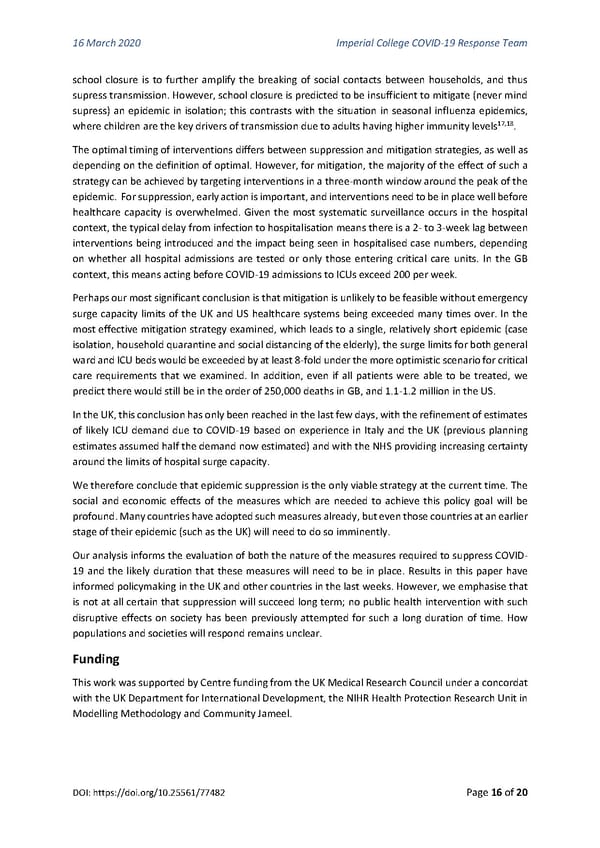16 March 2020 Imperial College COVID-19 Response Team school closure is to further amplify the breaking of social contacts between households, and thus supress transmission. However, school closure is predicted to be insufficient to mitigate (never mind supress) an epidemic in isolation; this contrasts with the situation in seasonal influenza epidemics, 17,18 where children are the key drivers of transmission due to adults having higher immunity levels . The optimal timing of interventions differs between suppression and mitigation strategies, as well as depending on the definition of optimal. However, for mitigation, the majority of the effect of such a strategy can be achieved by targeting interventions in a three-month window around the peak of the epidemic. For suppression, early action is important, and interventions need to be in place well before healthcare capacity is overwhelmed. Given the most systematic surveillance occurs in the hospital context, the typical delay from infection to hospitalisation means there is a 2- to 3-week lag between interventions being introduced and the impact being seen in hospitalised case numbers, depending on whether all hospital admissions are tested or only those entering critical care units. In the GB context, this means acting before COVID-19 admissions to ICUs exceed 200 per week. Perhaps our most significant conclusion is that mitigation is unlikely to be feasible without emergency surge capacity limits of the UK and US healthcare systems being exceeded many times over. In the most effective mitigation strategy examined, which leads to a single, relatively short epidemic (case isolation, household quarantine and social distancing of the elderly), the surge limits for both general ward and ICU beds would be exceeded by at least 8-fold under the more optimistic scenario for critical care requirements that we examined. In addition, even if all patients were able to be treated, we predict there would still be in the order of 250,000 deaths in GB, and 1.1-1.2 million in the US. In the UK, this conclusion has only been reached in the last few days, with the refinement of estimates of likely ICU demand due to COVID-19 based on experience in Italy and the UK (previous planning estimates assumed half the demand now estimated) and with the NHS providing increasing certainty around the limits of hospital surge capacity. We therefore conclude that epidemic suppression is the only viable strategy at the current time. The social and economic effects of the measures which are needed to achieve this policy goal will be profound. Many countries have adopted such measures already, but even those countries at an earlier stage of their epidemic (such as the UK) will need to do so imminently. Our analysis informs the evaluation of both the nature of the measures required to suppress COVID- 19 and the likely duration that these measures will need to be in place. Results in this paper have informed policymaking in the UK and other countries in the last weeks. However, we emphasise that is not at all certain that suppression will succeed long term; no public health intervention with such disruptive effects on society has been previously attempted for such a long duration of time. How populations and societies will respond remains unclear. Funding This work was supported by Centre funding from the UK Medical Research Council under a concordat with the UK Department for International Development, the NIHR Health Protection Research Unit in Modelling Methodology and Community Jameel. DOI: https://doi.org/10.25561/77482 Page 16 of 20
 Non-Pharmaceutical Interventions to reduce COVID-19 mortality and healthcare demand Page 15 Page 17
Non-Pharmaceutical Interventions to reduce COVID-19 mortality and healthcare demand Page 15 Page 17